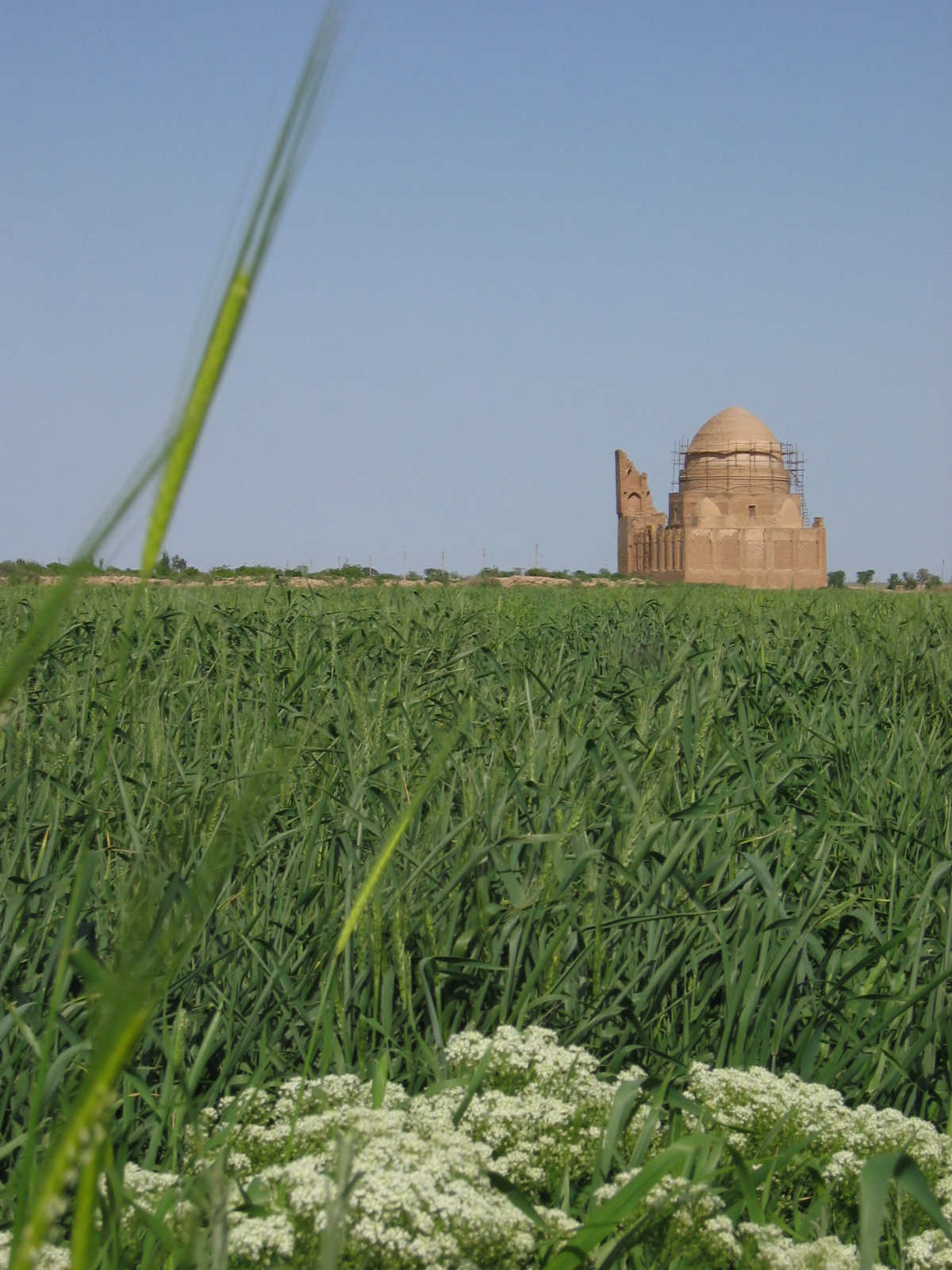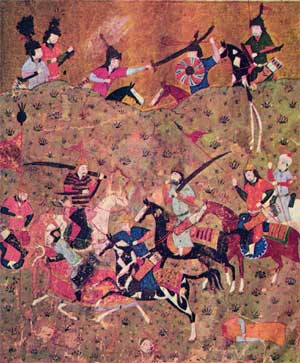|
Battle Of Sarakhs (1038)
The Battle of Sarakhs took place between the Seljuk Turks and the Ghaznavid state during which Tughril Beg and Chaghri Beg inflicted a major defeat against the Ghaznavids.Demirci, Mustafa, and Sinan Saçar"Selçukluların Nîşâbur’a girişi ve Gazneli bürokrasisinin tepkisi."Selçuk Üniversitesi Sosyal Bilimler Enstitüsü Dergisi 41 (2019): 281-292.Sicker, Martin.&nbsThe Islamic world in ascendancy : from the Arab conquests to the siege of Vienna.nbsp;United Kingdom: Praeger, 2000. When the Ghaznavid sultan Mahmhud returned from India he blamed his general Subashi for events that had occurred during his absence. He ordered Subashi to march against the Seljuks with his army and wage a battle against them. Subashi marched against the Seljuks. Once the Seljuks had heard of his advance they decided to confront the Ghaznavid army. The two armies met in a day long fight at Sarakhs Sarakhs ( fa, سرخس, Saraxs, also Romanized as Serakhs) is a city in Sarakhs Cou ... [...More Info...] [...Related Items...] OR: [Wikipedia] [Google] [Baidu] |
Sarakhs
Sarakhs ( fa, سرخس, Saraxs, also Romanized as Serakhs) is a city in Sarakhs County, Razavi Khorasan Province, Iran. Sarakhs was once a stopping point along the Silk Road, and in its 11th century heyday had many libraries. Much of the original city site is now just across the border at Serakhs in Turkmenistan. According to the most recent national census, in 2006, the city's population was 33,571 in 8,066 families. History Several battles were fought in this area. According to Ferdowsi's Shahnameh the town has existed since the Afrasiab period and was named for its builder, Sarakhs, son of Godarz, by Keykavus. The surrounding oasis has been inhabited since 2nd millennium BCE and Turkmen historians consider the city to have been founded in 507 BCE. Although this is considered to be a somewhat arbitrary choice of date, the section of the city called Sarahs that's now on the Turkmenistan side of the border, duly celebrated its 2500th anniversary in 1993. The Mongols plundere ... [...More Info...] [...Related Items...] OR: [Wikipedia] [Google] [Baidu] |
Ghaznavids
The Ghaznavid dynasty ( fa, غزنویان ''Ġaznaviyān'') was a culturally Persianate, Sunni Muslim dynasty of Turkic ''mamluk'' origin, ruling, at its greatest extent, large parts of Persia, Khorasan, much of Transoxiana and the northwest Indian subcontinent from 977 to 1186. The dynasty was founded by Sabuktigin upon his succession to the rule of Ghazna after the death of his father-in-law, Alp Tigin, who was an ex-general of the Samanid Empire from Balkh, north of the Hindu Kush in Greater Khorasan. Sabuktigin's son, Mahmud of Ghazni, expanded the Ghaznavid Empire to the Amu Darya, the Indus River and the Indian Ocean in the east and to Rey and Hamadan in the west. Under the reign of Mas'ud I, the Ghaznavid dynasty began losing control over its western territories to the Seljuk dynasty after the Battle of Dandanaqan, resulting in a restriction of its holdings to modern-day Afghanistan and Pakistan (Punjab and Balochistan). In 1151, Sultan Bahram Shah lost Ghazni to ... [...More Info...] [...Related Items...] OR: [Wikipedia] [Google] [Baidu] |
Seljuk Empire
The Great Seljuk Empire, or the Seljuk Empire was a high medieval, culturally Turko-Persian, Sunni Muslim empire, founded and ruled by the Qïnïq branch of Oghuz Turks. It spanned a total area of from Anatolia and the Levant in the west to the Hindu Kush in the east, and from Central Asia in the north to the Persian Gulf in the south. The Seljuk Empire was founded in 1037 by Tughril (990–1063) and his brother Chaghri (989–1060), both of whom co-ruled over its territories; there are indications that the Seljuk leadership otherwise functioned as a triumvirate and thus included Musa Yabghu, the uncle of the aforementioned two. From their homelands near the Aral Sea, the Seljuks advanced first into Khorasan and into the Iranian mainland, where they would become largely based as a Persianate society. They then moved west to conquer Baghdad, filling up the power vacuum that had been caused by struggles between the Arab Abbasid Caliphate and the Iranian Buyid Empire. T ... [...More Info...] [...Related Items...] OR: [Wikipedia] [Google] [Baidu] |
Chaghri
Abu Suleiman Dawud Chaghri Beg ibn Mikail, widely known simply as Chaghri Beg (989–1060), ''Da'ud b. Mika'il b. Saljuq'', also spelled Chaghri, was the co-ruler of the early Seljuk Empire. The name ''Chaghri'' is Turkic (Çağrı in modern Turkish) and literally means "small falcon", "merlin". Background Chaghri and his brother Tughril were the sons of Mikail and the grandsons of Seljuk. The Great Seljuk Empire was named after the latter, who was a Turkic clan leader either in Khazar or Oghuz states. In the early years of the 11th century, they left their former home and moved near the city of Jend (now a village) by the Syr Darya river, where they accepted the suzerainty of the Karakhanids in Transoxania (roughly modern Uzbekistan and southern Kazakhstan). After the defeat of the Karakhanids by Ghaznavids, they were able to gain independence. Biography Very little is known of Chaghri and Tughril's lives until 1025. Both were raised by their grandfather Seljuk until they ... [...More Info...] [...Related Items...] OR: [Wikipedia] [Google] [Baidu] |
Toghrül
Abu Talib Muhammad Tughril ibn Mika'il ( fa, ابوطالب محمد تغریل بن میکائیل), better known as Tughril (; also spelled Toghril), was a Turkmen"The defeat in August 1071 of the Byzantine emperor Romanos Diogenes by the Turkomans at the battle of Malazgirt (Manzikert) is taken as a turning point in the history of Anatolia and the Byzantine Empire. chieftain, who founded the Seljuk Empire, ruling from 1037 to 1063. Tughril united many Turkmen warriors of the Central Asian steppes into a confederacy of tribes and led them in conquest of Khorasan and eastern Persia. He would later establish the Seljuk Sultanate after conquering Persia and taking the Abbasid capital of Baghdad from the Buyids in 1055. Tughril relegated the Abbasid Caliphs to state figureheads and took command of the caliphate's armies in military offensives against the Byzantine Empire and the Fatimids in an effort to expand his empire's borders and unite the Islamic world. Before the adven ... [...More Info...] [...Related Items...] OR: [Wikipedia] [Google] [Baidu] |
Tughril Beg
Abu Talib Muhammad Tughril ibn Mika'il ( fa, ابوطالب محمد تغریل بن میکائیل), better known as Tughril (; also spelled Toghril), was a Turkmen"The defeat in August 1071 of the Byzantine emperor Romanos Diogenes by the Turkomans at the battle of Malazgirt (Manzikert) is taken as a turning point in the history of Anatolia and the Byzantine Empire. chieftain, who founded the Seljuk Empire, ruling from 1037 to 1063. Tughril united many Turkmen warriors of the Central Asian steppes into a confederacy of tribes and led them in conquest of Khorasan and eastern Persia. He would later establish the Seljuk Sultanate after conquering Persia and taking the Abbasid capital of Baghdad from the Buyids in 1055. Tughril relegated the Abbasid Caliphs to state figureheads and took command of the caliphate's armies in military offensives against the Byzantine Empire and the Fatimids in an effort to expand his empire's borders and unite the Islamic world. Before the advent of ... [...More Info...] [...Related Items...] OR: [Wikipedia] [Google] [Baidu] |
Chaghri Beg
Abu Suleiman Dawud Chaghri Beg ibn Mikail, widely known simply as Chaghri Beg (989–1060), ''Da'ud b. Mika'il b. Saljuq'', also spelled Chaghri, was the co-ruler of the early Seljuk Empire. The name ''Chaghri'' is Turkic (Çağrı in modern Turkish) and literally means "small falcon", "merlin". Background Chaghri and his brother Tughril were the sons of Mikail and the grandsons of Seljuk. The Great Seljuk Empire was named after the latter, who was a Turkic clan leader either in Khazar or Oghuz states. In the early years of the 11th century, they left their former home and moved near the city of Jend (now a village) by the Syr Darya river, where they accepted the suzerainty of the Karakhanids in Transoxania (roughly modern Uzbekistan and southern Kazakhstan). After the defeat of the Karakhanids by Ghaznavids, they were able to gain independence. Biography Very little is known of Chaghri and Tughril's lives until 1025. Both were raised by their grandfather Seljuk until t ... [...More Info...] [...Related Items...] OR: [Wikipedia] [Google] [Baidu] |
Mahmud Of Ghazni
Yamīn-ud-Dawla Abul-Qāṣim Maḥmūd ibn Sebüktegīn ( fa, ; 2 November 971 – 30 April 1030), usually known as Mahmud of Ghazni or Mahmud Ghaznavi ( fa, ), was the founder of the Turkic Ghaznavid dynasty, ruling from 998 to 1030. At the time of his death, his kingdom had been transformed into an extensive military empire, which extended from northwestern Iran proper to the Punjab in the Indian subcontinent, Khwarazm in Transoxiana, and Makran. Highly Persianized, Mahmud continued the bureaucratic, political, and cultural customs of his predecessors, the Samanids. He established the ground for a future Persianate state in Punjab, particularly centered on Lahore, a city he conquered. His capital of Ghazni evolved into a significant cultural, commercial, and intellectual centre in the Islamic world, almost rivalling the important city of Baghdad. The capital appealed to many prominent figures, such as al-Biruni and Ferdowsi. Mahmud ascended the throne at the a ... [...More Info...] [...Related Items...] OR: [Wikipedia] [Google] [Baidu] |
Battles Involving The Seljuk Empire
A battle is an occurrence of combat in warfare between opposing military units of any number or size. A war usually consists of multiple battles. In general, a battle is a military engagement that is well defined in duration, area, and force commitment. An engagement with only limited commitment between the forces and without decisive results is sometimes called a skirmish. The word "battle" can also be used infrequently to refer to an entire operational campaign, although this usage greatly diverges from its conventional or customary meaning. Generally, the word "battle" is used for such campaigns if referring to a protracted combat encounter in which either one or both of the combatants had the same methods, resources, and strategic objectives throughout the encounter. Some prominent examples of this would be the Battle of the Atlantic, Battle of Britain, and Battle of Stalingrad, all in World War II. Wars and military campaigns are guided by military strategy, whereas ba ... [...More Info...] [...Related Items...] OR: [Wikipedia] [Google] [Baidu] |




.jpg)

